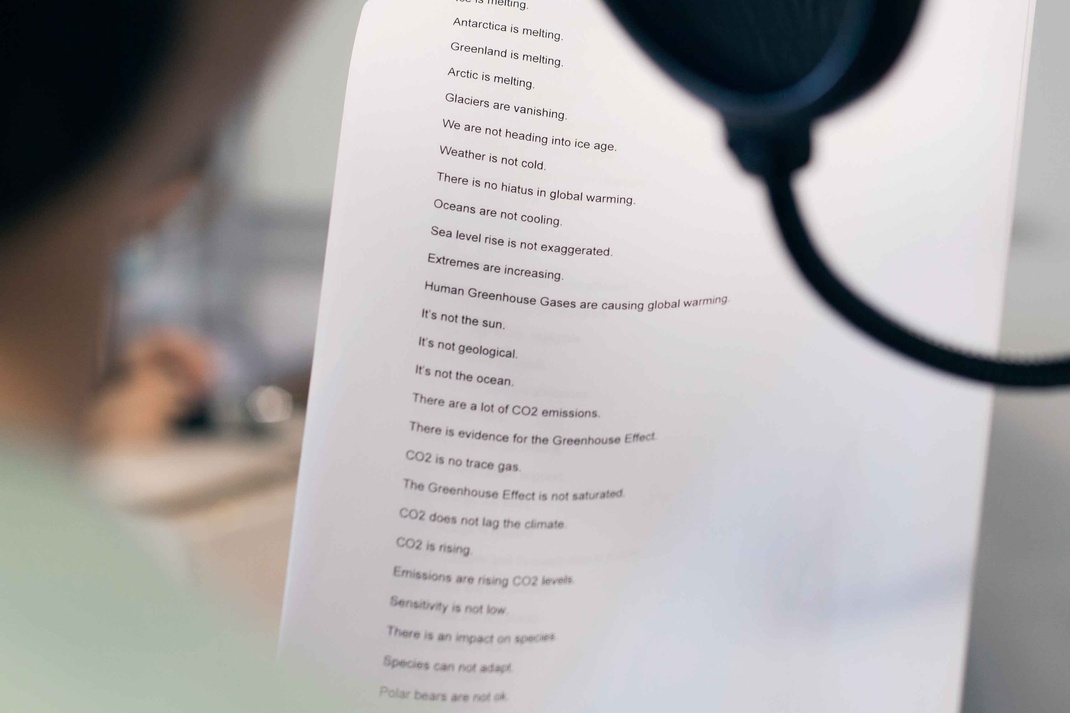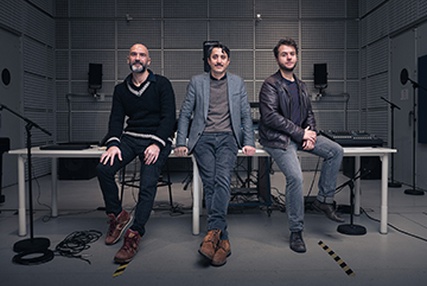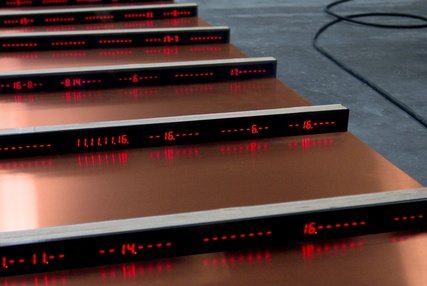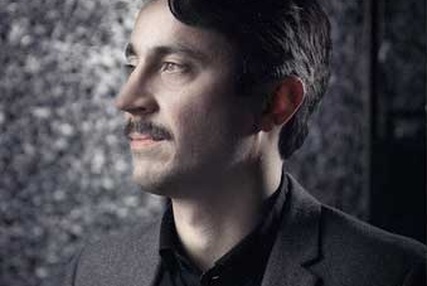Pour sa Critical Climate Machine – et notamment pour toute la partie algorithmique d’analyse des arguments climatosceptiques qui constitue la matière première de cette « sculpture de données » –, Gaëtan Robillard s’est largement appuyé sur les travaux de John Cook, chercheur australien en psychologie cognitive à l’université de Monash (Melbourne). L’occasion pour nous d’en savoir un peu plus sur cette science qu’est la « communication sur le climat ».
John Cook, comment en êtes-vous arrivé à consacrer votre carrière scientifique au « déni climatique » ?
 Ça a commencé par un débat sur le réchauffement climatique que j’ai eu avec mon beau-père lors d’une fête de famille. Mon beau-père était climatosceptique et, de mon côté, je n’étais pas encore très impliqué dans le domaine. Suite à ces conversations, je me suis mis à faire des recherches sur les divers arguments qu’il avait avancés, et je me suis aperçu qu’aucun n’était sérieusement étayé de manière scientifique.
Ça a commencé par un débat sur le réchauffement climatique que j’ai eu avec mon beau-père lors d’une fête de famille. Mon beau-père était climatosceptique et, de mon côté, je n’étais pas encore très impliqué dans le domaine. Suite à ces conversations, je me suis mis à faire des recherches sur les divers arguments qu’il avait avancés, et je me suis aperçu qu’aucun n’était sérieusement étayé de manière scientifique.
Comme tout gendre qui se respecte et déteste laisser le dernier mot à son beau-père, j’ai commencé à dresser une liste de tous les arguments qu’il pourrait m’opposer au cours de futures fêtes de famille, en les accompagnant évidemment de leurs réfutations scientifiques. J’ai fait des études de physique, mais, mon diplôme en poche, je me suis tourné vers le graphisme – donc tout autre chose. Cela étant, cette formation scientifique initiale a été précieuse pour parvenir à lire et à comprendre les articles les plus sérieux sur le sujet – d’autant plus que j’ai eu tendance à aller vers les sources premières, en m’appuyant exclusivement sur des papiers publiés dans des revues avec évaluation par les pairs. Au fil du temps, je me suis dit que cette liste pourrait servir à d’autres et je l’ai donc mise en ligne sur le site skepticalscience.com.
C’est ainsi que, à mon insu, je suis revenu aux sciences. Car, ce que je ne savais pas, c’est que ce travail de recherche s’apparente à de la recherche en « Communication sur le climat », qui est aujourd’hui une discipline scientifique à part entière ! Venant de la physique, j’avais la naïveté de croire que transmettre les résultats scientifiques tels quels était suffisant. Ce qui, surtout s’agissant du climat, est tout sauf vrai : de nombreux aspects, psychologiques notamment, entrent en jeu dans la communication des faits établis. De fil en aiguille, j’en suis venu à faire un doctorat en psychologie cognitive, au sujet de la désinformation sur le climat.
Vous avez mis au point des algorithmes de détection et de classification des arguments climatosceptiques en ligne – algorithmes qui ont servi de base à ceux utilisés par Gaëtan Robillard pour Critical Climate Machine – : comment est née l’idée ? Que font ces algorithmes ?
Voilà plusieurs années, j’ai été contacté par deux scientifiques : Travis G. Coan, chercheur en Computational Social Science à l’université d’Exeter (Royaume-Uni) et Constantine Boussalis, chercheur en science politique au Trinity College de Dublin (Irlande). Ils venaient de publier un article de recherche sur des modèles d’analyse de thèmes climatosceptiques. Dit simplement, ils balayaient Internet à la recherche de désinformations sur le climat, pour en dégager les principaux thèmes. Connaissant mon travail, ils voulaient mon avis sur leurs recherches.
Outre mon avis, je leur ai suggéré d’utiliser les méthodes d’apprentissage machine qu’ils avaient développées dans le cadre de leurs travaux pour tester des affirmations climatosceptiques (comme « le climat ne se réchauffe pas » ou « l’humanité n’est pas en cause », etc.). C’est ainsi que nous nous sommes lancés dans une recherche au long cours. La première étape a été de dresser une taxonomie de tous les arguments et affirmations climatosceptiques, ce qui nous a servis à entraîner méthodiquement les modèles informatiques. Sur le principe, ça a l’air simple – on trouve un texte et, si l’on y détecte une affirmation fausse ou faussée, on la classifie selon la taxonomie établie, et on l’indique à la machine. Le problème est bien sûr que cela suppose de répéter le processus des dizaines de milliers de fois jusqu’à ce que la machine soit suffisamment entraînée.
Quel était votre objectif ?
Le but ultime est ce que j’appellerais le « Graal du fact-checking » : c’est-à-dire détecter en temps réel la désinformation, et la « débunker » illico, c’est-à-dire la contrer avec le bon argument avant qu’elle ait le temps de se répandre. La désinformation ayant la capacité de se diffuser quasi instantanément, l’idée est de la prendre de vitesse.
La partie « apprentissage machine » que je viens de décrire n’est donc que la première étape d’un processus plus vaste, que nous avons appelé les « 4D » : Détecter-Déconstruire-Débunker-Diffuser.
Où en êtes-vous de ce travail ?
Au premier « D » : la détection. Reste à trouver comment déconstruire rapidement une affirmation fausse (comprendre ce qui est faux dans l’affirmation, ce qui peut être assez complexe puisqu’une même affirmation peut faire appel à divers arguments qu’il faut chacun comprendre et réfuter), lui associer immédiatement la réfutation adéquate (générer automatiquement un texte de fact-checking adapté), puis la diffuser.
Cette dernière étape est tout aussi complexe : comment déployer cet outil qu’on aura élaboré pour qu’il ait un véritable impact ? Nous développons par exemple depuis un an une extension destinée aux navigateurs Internet – qui signalera par un pop-up, par exemple, les faux arguments et affirmations dans une page visitée, et les démontera immédiatement.
Nous espérons pouvoir en sortir une version publique d’ici la fin de l’année.

© Gaëtan Robillard
Quel a été votre sentiment quand Gaëtan Robillard vous a parlé de son installation Critical Climate Machine ?
Après mon diplôme en physique, en plus du graphisme, j’ai aussi fait un peu de BD. J’ai donc un bagage scientifique, mais aussi artistique. Et je suis convaincu que les arts créatifs peuvent être un outil efficace d’éveil des consciences sur de tels enjeux brûlants. J’ai donc été immédiatement très enthousiaste à l’idée d’une œuvre d’art qui, en trouvant un débouché créatif à toutes ces données, sensibiliserait au sujet non seulement du réchauffement climatique, mais aussi des recherches sur la désinformation climatique.
Dans le même ordre d’idées, après avoir vu le film de Cli-Fi Don’t Look Up, je me suis demandé si on ne pourrait pas utiliser ce travail dans un cadre fictionnel : par exemple, pourquoi ne pas exploiter la taxonomie que nous avons établie pour raconter une histoire ? Utiliser la créativité pour sensibiliser le public peut être extrêmement puissant. Et tous les moyens sont bons pour toucher les gens.
Propos recueillis par Jérémie Szpirglas
Crédits portrait : © John Cook
![]()
La Critical Climate Machine sera exposée dans sa version complète (incluant tous les aspects : sculpture, installation sonore, etc.) du 12 au 22 octobre à Grenoble, dans le cadre d’EXPERIMENTA, Biennale Arts Sciences. https://www.atelier-arts-sciences.eu/
Critical Climate Machine fait partie du projet MediaFutures, dont l’Ircam est partenaire. Dans ce contexte, Critical Climate Machine a reçu un financement du programme-cadre Horizon 2020 de l’Union européenne pour la recherche et l’innovation, sous la convention de subvention n° 951962. Critical Climate Machine (Patterns of Heat) fait également partie de The Intelligent Museum, financé par le programme de culture numérique de la Fondation culturelle fédérale allemande (Kulturstiftung des Bundes) et par le Commissaire du gouvernement fédéral à la culture et aux médias (Beauftragte der Bundesregierung für Kultur und Medien).





